
2018 was by most measures a pretty great year for public education. It seemed that finally - finally - the conversation about the future of public education was headed in the right direction. The country was actually listening to educators. There were many other successes for public schools in 2018, but also enough disappointments and outrages to splash a little cold water on any year-end celebration.
Here are some of the highlights and lowlights for 2018. (It's hardly an exhaustive list, so use the comments field to add your own suggestions.)
Cheers - #RedforEd
The sweeping mobilization of educators demanding reinvestment in our schools and respect for their profession was the education story of 2018. In February, 6,000 teachers and education support professionals in West Virginia, fed up with empty promises by lawmakers and the exodus of their colleagues to neighboring states, launched a statewide strike and, in the process, a national #RedforEd movement to protect the future of public education.
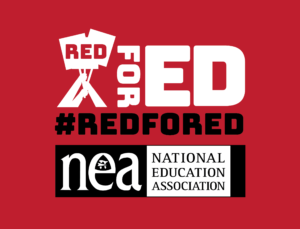 In early April, educators in Kentucky, Oklahoma, and Colorado took to the streets. Weeks later, Arizona educators voted to walk out in the largest state-wide action yet. Every one of these campaigns resulted in victories for increased funding for students and higher pay for educators. Momentum is only growing as more actions in a new crop of states are planned in early 2019.
In early April, educators in Kentucky, Oklahoma, and Colorado took to the streets. Weeks later, Arizona educators voted to walk out in the largest state-wide action yet. Every one of these campaigns resulted in victories for increased funding for students and higher pay for educators. Momentum is only growing as more actions in a new crop of states are planned in early 2019.
Polls in 2018 also showed that the American public overwhelmingly support more money for schools, professional salaries for teachers, and the use of strikes to bring about these changes. After a decade of "blaming teachers first" - a message cultivated by privatization proponents and the national media - the country, thanks to #RedforEd, got a look at the true guardians of our public schools and liked what they saw.
Jeers - DeVos Dismantles Civil Rights Protections
In addition to pushing a national expansion of private school vouchers, Education Secretary Betsy DeVos has been spending most of her time rolling back civil rights protections for our most vulnerable students. She wasted no time after her contentious confirmation in February 2017 when she rescinded the Obama-era guidance that schools should allow students to use restrooms consistent with their gender identity in accordance with Title IX.
In November 2018, DeVos undermined Title IX further when she weakened protections for sexual assault and harassment survivors in K-12 schools as well as colleges and universities.
In December, the Trump administration released the report from the Federal Commission on School Safety to address gun violence in schools. The report recommends stripping protections that seek to prevent racial disparities in student discipline. These guidelines were put into place to address the wide racial gap in school suspensions and expulsions.
The move by the Department of Education could reverse the progress schools are seeing as they introduce alternative, less punitive discipline policies, says Linda Darling-Hammond of Stanford University.
In a recent column co-authored with Christopher Edley, Darling-Hammond writes: "Given the extensive research base behind the guidance, and its capacity to help prevent exclusionary and discriminatory discipline practices, rescinding it will exacerbate the inequities in our education system, while rolling back progress on school safety and student attainment."
Cheers - Election 2018
One of the offshoots of the #RedforEd movement was the unprecedented number of educators who decided in 2018 to step up and run for public office. Their efforts helped generate the enthusiasm that delivered major wins for students and public schools on election day. Nearly 15 percent of all state legislative seats in the United States will be held by elected educators, according to an NEA analysis. Come January, the majority of Americans will be led by governors with a proven track record of championing public education.
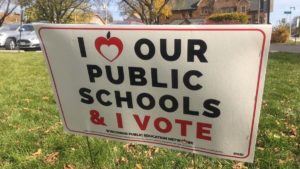
The lesson in November for lawmakers was simple, said NEA President Lily Eskelsen García. “You can either work with educators to address the needs of students and public education, or they will work to elect someone who will."
Nearly 220,000 NEA members and education families were involved in getting out the vote in 2018 - a 165 percent increase in activism engagement compared with 2016, a presidential year where activism is historically higher than midterms.
Jeers - Corporate Tax Breaks Breaking U.S. Schools
During the 2018 election cycle, no candidate from either party wanted to be seen as a champion of cutting education funding. Quite the opposite. Boosting spending on schools is a politically popular position, and the election of candidates who made this a central part of their platform means the public wants them to deliver on this promise.
 A good place to start strengthening school revenue sources, said Eskelsen García at a recent post-election panel at the National Press Club, would be economic development tax incentives granted to corporations. “It’s always called an 'economic development program' but study after study shows that the promised job creation and new revenues never materialize.”
A good place to start strengthening school revenue sources, said Eskelsen García at a recent post-election panel at the National Press Club, would be economic development tax incentives granted to corporations. “It’s always called an 'economic development program' but study after study shows that the promised job creation and new revenues never materialize.”
And then there's the jaw-dropping cost to public schools. According to a report by Good Jobs First, in 2017 schools lost $1.8 billion across 28 states through corporate tax incentives.
Although proponents of these tax giveaways argue these deals boost development and investment and grow local economies, they ignore the economic impact of starving the education system.
“It is no exaggeration to say that when tax abatements cause school districts to have fiscal stress and reduce school quality, they are undermining the local ‘business climate,’” the report states.
What could this money have been used for? If it were reinvested in hiring new teachers and reducing class size, the ten most affected states alone could add more than 28,000 teachers.
Cheers - Student Activists Show the Way
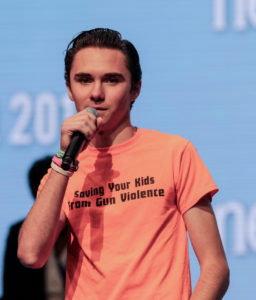 Student activist David Hogg speaks at the NEA Representative Assembly. (Photo: Calvin Knight)
Student activist David Hogg speaks at the NEA Representative Assembly. (Photo: Calvin Knight)
The headlines were becoming numbingly familiar: “Another School Shooting Traumatizes Students, Community,” followed days or maybe weeks later with “No Action on Gun Violence Expected.” Thanks to the extraordinary efforts of student activists, however, politicians were not going to get off easily in 2018. Following the shooting in February in Parkland, Florida, student activists stood up and revitalized the stalled movement to demand action to end gun violence.
Student are also making their voices heard in the #MeToo movement and the campaign to end zero tolerance and bring restorative practices to schools.
“We have been speaking up, mobilizing, and standing strong because our friends and family mean the world to us,” student activist David Hogg told NEA delegates. “We are young and that means we don’t have to accept the status quo. And we never will. We intend to close the gap between the world as it is and what it should be.”
Jeers - Arming Educators
The recent report by the Federal Commission on School Safety backed off from mandating schools arm and train teachers, although the proposal is still offered in the report as a possible solution to gun violence in schools. So while it was downplayed somewhat, this preposterous idea lives on. President Trump and Betsy DeVos immediately floated the measure following the Parkland shooting in February 2018. Unfortunately, too many lawmakers, eager to divert the public’s attention away from real solutions to gun violence, were all too eager to run with it.
The response from educators, parents, and many law enforcement officials was swift: arming teachers was a ludicrous and dangerous idea. According to an NEA poll, 74% of educators opposed the measure. Eighty percent said they would not carry a gun in school. Even among NEA members who own guns, 63% said they would not agree to be armed in school. Two-thirds said they would feel less safe if school personnel were armed.
Cheers - Unions Flex Their Muscle
In June, the U.S. Supreme Court ruled in Janus v. AFSCME Council 31, that requiring fair-share fees in the public sector violated the First Amendment of the Constitution. With the decision, the court weakened the right of educators and other working people to come together in unions and to bargain collectively, effectively siding with corporate interests intent on rigging the economic system further in their favor.
While the Janus decision has undoubtedly created a more challenging climate for unions, it has also served as a rallying point, said Eskelsen García. “We're not going anywhere,” she said. “Unions will continue to be the best vehicle on the path to the middle class.”
Support for labor unions has risen to its highest level in years and millions of American workers have recommitted to their unions and launched new organizing drives across the country. Through their union, educators in West Virginia, Oklahoma, Kentucky, Colorado, Arizona, and North Carolina spoke up and advocated for their students.
 (AP Photo/Michael Conroy)
(AP Photo/Michael Conroy)
Opponents were hoping to see a downsizing of union organizing around the 2018 elections, which clearly didn't materialize. Educator activism was at an all-time high as the NEA and its affiliates mobilized their members across the country - even helping many of them to run for office.
“Educators are still organized, still aware of their rights, and still ready to defend those rights when they deem it necessary,” Sarah Jones recently wrote in New York magazine. "Janus did not eliminate the incentives for union membership. Organizing still works, and as long as that holds true, people will continue to join unions."
Jeers - State Policy Network
This mobilization by educators and their unions comes at a time when the same corporate interests that bankrolled the Janus case have turned their attention to conducting well-funded, deceptive campaigns that are urging union members to stop paying dues.
Their goal is no less than to “defund and defang” public service labor unions.
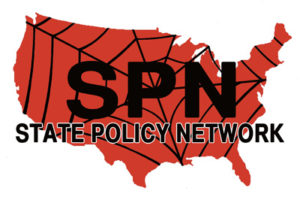 Credit: SourceWatch
Credit: SourceWatch
The entity behind these campaigns is the innocuously-named State Policy Network, a coalition of 66 separate “think tanks” funded by the Kochs, Mercers, Waltons, and other billionaires who will not rest until the “public” is permanently taken out of public education. In addition to knee-capping unions and pushing school vouchers, the SNP is funneling millions of dollars into campaigns to undermine public pensions and Medicaid.
Cheers - School Privatization Takes a Hit
On election day, Arizona voters rejected Proposition 305, which would have expanded the state's school voucher program to all of the state's 1.1 million public school students. The vote wasn't even close.
In California, former charter school executive Marshall Tuck was defeated by Tony Thurmond in the race for State Superintendent of Public Instruction of California. Thurmond opposes diverting public money to charter schools (“I intend to be a champion of public schools,” he said in his victory statement). The charter school industry spent more than $30 million boosting Tuck's losing campaign, a stunning defeat in a state where charters had enjoyed almost unfettered growth.
 Across the midwest, gubernatorial candidates cruised to victory running on platforms opposing any type of school voucher program and calling for more accountability and oversight over charter schools.
Across the midwest, gubernatorial candidates cruised to victory running on platforms opposing any type of school voucher program and calling for more accountability and oversight over charter schools.
To be sure, school privatization remains a major force. Its march across the United States over the past decade is going to be difficult to reverse. Still, there's little doubt that momentum has stalled, perhaps significantly. Despite school vouchers making inroads in many states, the majority of the U.S. public oppose the idea of siphoning off money from public schools to pay for private school tuition. The proliferation of charter schools, on the other hand, has slowed down as scrutiny over mismanagement and mixed academic results has intensified. (The colossal failures of cyber charter schools have been a major embarrassment.)
Looking ahead to 2019, Jon Valant of the Brown Center on Education Policy at the Brookings Institution told the Associated Press, “There’s not a ton of optimism for charters and choice. I think there’s a cultural and political shift on what charters are that actually presents a more fundamental problem.”
Jeers - Dreamers Still in Limbo
One year ago, in December 2017, the U.S. Congress adjourned for the holidays without taking action to find a permanent legislative solution for our nation’s Dreamers —young people brought to the U.S. as children, who received the Deferred Action for Childhood Arrivals, or DACA.
The 800,000 Dreamers were hoping for an agreement that would provide them with permanent legal status.
One year later, Congress still hasn't taken action.
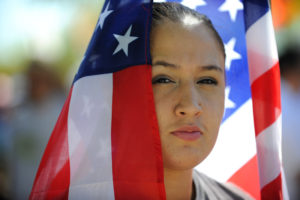 In September 2017, President Donald Trump, in a callous move, rescinded the program, and then told lawmakers to come up with a solution. The move only sparked fear and uncertainty among the 600,000 who are high school or college students, and the nearly 9,000 who are educators.
In September 2017, President Donald Trump, in a callous move, rescinded the program, and then told lawmakers to come up with a solution. The move only sparked fear and uncertainty among the 600,000 who are high school or college students, and the nearly 9,000 who are educators.
Despite overwhelming public support for the Dream Act, efforts to find permanent solution have been held hostage by political posturing over immigration policy and border security.
The grueling setbacks have not dashed the hopes of these hundreds of thousands of aspiring Americans.
"They don’t realize all the work we’ve done, the allies we’ve made, and the foundation we’ve built," says Karen Reyes, a teacher in Austin, Texas. We’re not back to the beginning. We’re just on a detour.” (For more information and resources on supporting Dreamers, visit NEA EdJustice.)


